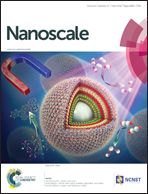Hybrid plasmonic gap modes in metal film-coupled dimers and their physical origins revealed by polarization resolved dark field spectroscopy†
Abstract
Plasmonic gap modes sustained by metal film-coupled nanostructures have recently attracted extensive research attention due to flexible control over their spectral response and significantly enhanced field intensities at the particle–film junction. In this work, by adopting an improved dark field spectroscopy methodology – polarization resolved spectral decomposition and colour decoding – we are able to “visualize” and distinguish unambiguously the spectral and far field radiation properties of the complex plasmonic gap modes in metal film-coupled nanosphere monomers and dimers. Together with full-wave numerical simulation results, it is found that while the monomer–film system supports two hybridized dipole-like plasmon modes having different oscillating orientations and resonance strengths, the scattering spectrum of the dimer–film system features two additional peaks, one strong yet narrow resonant mode corresponding to a bonding dipolar moment and one hybridized higher order resonant mode, both polarized along the dimer axis. In particular, we demonstrate that the polarization dependent scattering radiation of the film-coupled nanosphere dimer can be used to optically distinguish from monomers and concurrently determine the spatial orientation of the dimer with significantly improved accuracy at the single-particle level, illustrating a simple yet highly sensitive plasmon resonance based nanometrology method.


 Please wait while we load your content...
Please wait while we load your content...